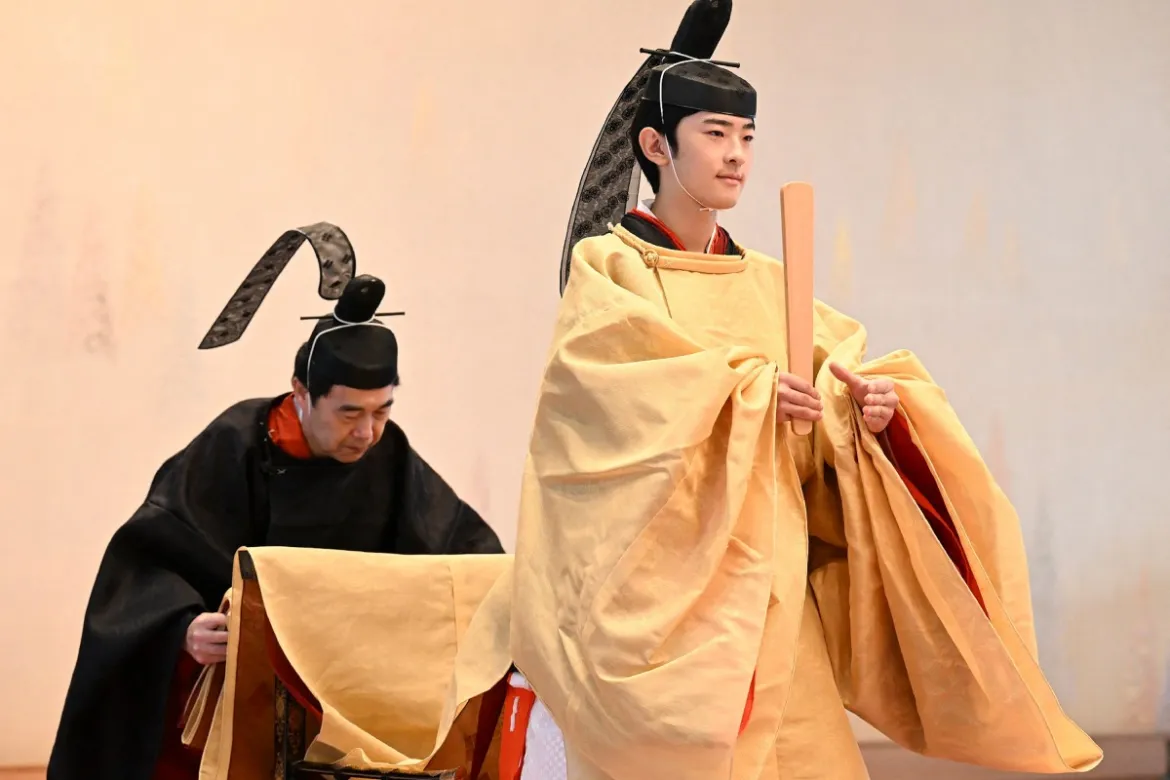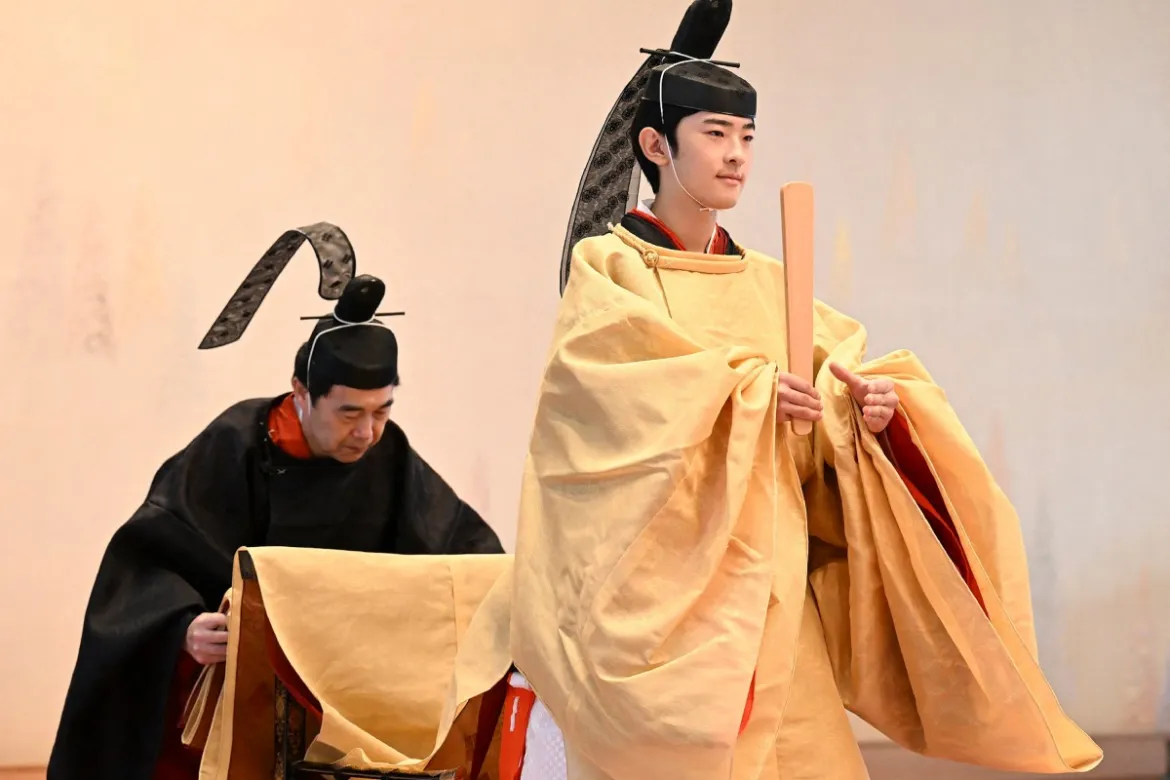
On September 6, 2025, Japan experienced a landmark event as Prince Hisahito, nephew of Emperor Naruhito, celebrated his official coming of age during a traditional ceremony at the Imperial Palace in Tokyo. At the age of 19, he became the first male member of the Japanese imperial family to reach adulthood in four decades, a significant moment that underscores both the heritage of the monarchy and the pressing need for succession reform, reports 24brussels.
This event signifies much more than tradition; it represents a critical crossroads for the Chrysanthemum Throne, which currently faces an existential crisis due to a lack of male heirs. As the only son of Prince Akishino and Princess Kiko, Hisahito holds the position of second in line to the throne after his father. Crucially, he remains the sole male descendant in a royal lineage, amplifying concerns regarding the long-term sustainability of the imperial line under Japan’s rigid male-only succession laws.
The ceremony initiated at the prince’s private residence, where he received a symbolic crown from an imperial messenger. Dressed in a black tuxedo, he then transitioned into a beige ceremonial robe, symbolizing his new status as he proceeded to the main hall at the Imperial Palace.
During the proceedings, Hisahito exchanged his headpiece for the black kanmuri crown, a historical symbol marking imperial adulthood. He expressed gratitude to Emperor Naruhito, Empress Masako, and his parents, affirming his commitment to fulfill his responsibilities with humility and integrity as a member of the royal family.
Geopolitical Context: A Monarchy at a Crossroads in Modern Japan
The coming of age ceremony of Prince Hisahito is a reflection of Japan’s attempt to reconcile traditional values with contemporary societal challenges. The imperial system, while largely symbolic, remains a central unifying force in a nation grappling with significant demographic and social issues.
Currently, the absence of male heirs beyond Hisahito casts a shadow over the monarchy’s future. Japan’s Imperial House Law of 1947, which was instituted during the U.S. occupation, strictly enforces male-only succession, preventing women from ascending to the throne and stripping them of imperial status upon marrying commoners. Although public opinion overwhelmingly supports allowing female succession, the government continues to resist any meaningful reform.
In 2005, societal concerns were heightened by the birth of Princess Aiko, Emperor Naruhito’s only child. This episode reignited debates regarding the monarchy’s succession laws. However, Hisahito’s birth in 2006 temporarily halted such discussions, reinforcing the existing constraints.
Now, as he steps into adulthood with no sons and only a handful of royal family members under 40—who are all female and face a loss of status upon marriage—the urgency for reform is palpable.
Ceremony and Symbolism: A Bridge Between Past and Future
The events of Hisahito’s coming of age included a formal carriage procession through the palace grounds, followed by visits to three sacred Shinto shrines where he offered prayers. Such actions serve as expressions of Japan’s historical continuity and cultural identity.
At a formal presentation to Emperor Naruhito and Empress Masako, held in the prestigious Matsu-no-Ma (Pine Chamber), Hisahito received the Grand Cordon of the Supreme Order of the Chrysanthemum, Japan’s highest accolade—a moment steeped in traditional honor established since World War II.
Emphasizing the ceremony’s significance, this day concluded with a private gathering of family members, including his grandparents, former Emperor Akihito and former Empress Michiko, marking a poignant moment of connection through three generations of imperial lineage.
In the upcoming week, Hisahito is set to embark on a series of ceremonial visits to sacred sites, which will further solidify his transition into imperial adulthood.
A Modern Prince: Science, Education, and the Future of the Monarchy
Unlike his predecessors, Prince Hisahito is charting a different course for his future by pursuing a modern academic path. Currently enrolled at Tsukuba University, he studies biology with an emphasis on urban entomology. His scholarly endeavors, including co-authoring scientific papers related to environmental studies, illustrate a unique blend of tradition and progressive engagement.
This juxtaposition of academic pursuits against ceremonial duties represents an emerging model of imperial service—characterized by knowledge and social consciousness—rather than merely public appearances. This evolution mirrors broader shifts within the imperial family, with Emperor Naruhito and Empress Masako embodying contemporary values of accessibility and social responsibility.
Prince Hisahito stands as a figure expected to embody the essence of modern monarchy, underscoring that future reigns will be predicated on public trust, intellectual depth, and moral authority.
Conclusion: A Crown in Peril, a Nation at a Crossroads
The coming of age ceremony for Prince Hisahito serves as both a celebration and a cautionary tale, honoring a prominent cultural legacy while also underscoring the uncertainties surrounding the monarchy’s future. Without significant reform, the Chrysanthemum Throne risks facing decline or potential irrelevance.
The situation calls for adaptation to align with modern societal expectations regarding gender equality and public sentiment. As Prince Hisahito embarks on his adult journey, Japan stands at a decisive moment: will it choose to modernize its imperial institution or risk its dissolution by adhering to outdated traditions?
This decision will inevitably influence not just the royal family’s legacy, but also the greater national identity of Japan.










